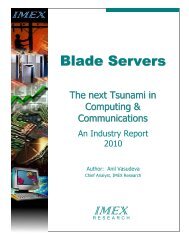Solving the IO Bottleneck in NextGen DataCenters ... - IMEX Research
Solving the IO Bottleneck in NextGen DataCenters ... - IMEX Research
Solving the IO Bottleneck in NextGen DataCenters ... - IMEX Research
Create successful ePaper yourself
Turn your PDF publications into a flip-book with our unique Google optimized e-Paper software.
Key Takeaways<br />
<strong>IMEX</strong><br />
RESEARCH.COM<br />
• <strong>Solv<strong>in</strong>g</strong> I/O Problems<br />
• I/O <strong>Bottleneck</strong>s occur at multiple places <strong>in</strong> <strong>the</strong> Compute Stack, <strong>the</strong> largest<br />
be<strong>in</strong>g at Storage I/O<br />
• SSD comes out cheaper/<strong>IO</strong>P for <strong>IO</strong> Intensive Apps<br />
• To get of Reads – Improve Index<strong>in</strong>g, archive out old data<br />
• M<strong>in</strong>imize <strong>the</strong> impact of writes – Get rid of temp tables/filesorts on slow<br />
disks.<br />
• Compress big varchar/text/blobs<br />
• Data Forensics and Tiered Placement<br />
• Every workload has unique I/O access signature<br />
• Historical performance data for a LUN can identify performance skews &<br />
hot data regions by LBAs<br />
• Use Smart Tier<strong>in</strong>g to identify hot LBA regions and non-disruptively migrate<br />
hot data from HDD to SSDs.<br />
• Typically 4-8% of data becomes a candidate and when migrated to SSDs<br />
can provide response time reduction of ~65% at peak loads<br />
© 2010‐11 <strong>IMEX</strong> <strong>Research</strong>, Copy<strong>in</strong>g prohibited. All rights reserved.





